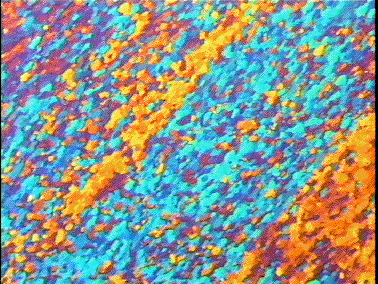- normal stress across a plane equal
- parallel stretching across a plane equal
simple shear component can be partitioned
Lecture 4B- Shear zones and kinematic indicators
Shear zones are planar zones of localised deformation.
shear zones are weaker than country rock.
Typically, there is a strong tendency towards non-coaxial
(simple shear) deformation within the shear zone. This because of compatibility
of strain rate and stress:
simple shear component can be partitioned |
|
Crustal levels & mechanisms
| Deformation mechanisms & localisation behaviour
varies with P,T, etc.
Shear zones may have long history and cut through large section of the crust. In general from upper to lower crust:
Ductile: displacement variation continuous Scale is important: small scale brittle can be large scale ductile |
| At same conditions one rock type or mineral may
have brittle behaviour and another ductile.
Within one shear zone, deformation structures may vary over time and in space. Different parts of the same shear zone (hanging wall / foot wall) may have different histories of deformation conditions. Shear along shear zone may vary within one deformation event and even more when shear zone is reactivated (opposite senses of shear very well possible) Result can be a wide variety of structures and overprinting relationships |
Main types of shear zone rocks from
shallow to deeper levels
Brittle fault rocks
fault breccia (cohesive / incohesive): >30% angular fragments
cataclasite (cohesive / incohesive): <30% angular fragments
fault gouge: very few isolated fragments in
very fine matrix
| A cohesive cataclasite with quartz fragments in a cohesive epidote-rich matrix. |
General reduction in grain size due to brittle processes (breaking of grains, "milling"). At very shallow levels the fault rocks can be incohesive. Dissolution/precipitation processes can contribute to the deformation and cement grains together: cohesive fault rocks.
Associated (micro-) structures:
Pseudotachylite
Pseudotachylite: melting on fault plane
during very rapid movement.
Dark very fine grained cohesive cataclasites & gouges can look very similar to pseudotachylites |
|
Mylonites are zones of strong to extreme localisation of ductile deformation.
Shear zone microstructures &
kinematic indicators
| Brittle structures
Riedel shears (Y, P, R, R' - shears) veins, vein arrays, fibres stepped faults |
|
passive markers layers/dykes, etc larger than shear zone. Important to know shear direction (lineation) and take into account orientation of marker relative to shear zone vein arrays (folding & boudinage). Rotation, stretching (boudinage) and shortening (folding) depends on orientation w.r.t. deformation. Shortening and stretching is possible during progressive deformation, but also take into account variations over time of applied deformation sheath folds. Extreme strains can shear out any irregularity in layering into a tubular fold. Fold axes, like most other fabric elements get transposed towards flow plane (S) and flow direction (L). Active buckling and rotation enhances formation of sheath folds. Fold asymmetry can indicate shear, but be careful: original orientation of plane & different asymmetry on limbs of larger scale fold. |
Shear bands & oblique foliations
Shear bands are small micro- or sub-shear
zones in larger scale shear zone, i.e. small scale localisation or strain
partitioning structures. They may look similar but are not the same as
crenulation cleavages, which normally develop normal to shortening. (->
extensional crenulation cleavage (=shear bands) versus compressional crenulation
cleavage).
|
C"=counterpart of C' in conjugate set; C" at high angle to SZB (rare) |
|
S-C fabric (Berthé et al. 1979, type I) often good shear sense indicator. Develops early in shear zone formation. C' (and C") are often late structures and may develop due to shear zone parallel shortening or stretching. Note: also look outside shear zone for this, since such shortening/stretching must also occur there (stress & strain rate compatibility) |
Oblique (grain shape) foliation mostly in rocks with one dominant mineral (e.g. micaceous quartzite). Angle <45o with flow plane. Combination of:
| Oblique foliation + mica fish: type II S-C fabric of Lister & Snoke (1984). |
 |
Domainal fabrics: different areas within rock that display contrasts in grain size, grain shape foliation, crystallographic preferred orientation or some other microstructure |
Porphyroclasts
(semi-) rigid objects cause local disturbance of stress field:
|
Range of possible results in object-matrix system: (a) loss of cohesion with extensional failure
(c) no loss of cohesion; deflection of deformation around lens including pressure shadow (strain dependent rheology, anisotropy / micas)
|
pressure shadows & fringes, very useful, see lecture 5.b
Fractured objects & tiling
Fractured objects: antithetic and synthetic fractures (unreliable shear sense indicator). Fracture orientation depends on relative orientations of:
Winged objects / mantled porphyroclasts. Porphyroclasts (typically feldspars) can have fine-grained mantles. The mantle forms by recrystallisation of the object rim, possibly with mixing in of matrix material (by grain boundary sliding and diffusion).
-> Mantle is not the same as pressure shadow
or pressure fringe
With high strain, mantles can get stretched to form
wings. Flow field and amount of mantle material determine geometry of mantled
porphyroclasts.
Two basic flow fields, defined by shape of separatrix
(planes that separate distinct flow fields)
d-objects (delta): mantle is partly outside of separatrix: part remains close to object, part flows away in long thin wings with embayments
f-objects (phi): long wings, but no embayments; mantle extended outside of separatrix; orthorhombic symmetry
sa-objects (sigma): long wings, but no embayments; mantle extended outside of separatrix; monoclinic symmetry. s-objects should not be confused with pressure shadows.
stair-stepping: the wings on either side of the object are parallel, but do not lie in the same plane. Upward step is in shear direction. Only use term (no) stair stepping when wings are long and parallel.
complex objects: objects with more than one
pair of wings.
| sb-objects (sigma): mantled porphyroclasts in S-C fabric. |
Quarter structures
Monoclinic symmetry of structures at porphyroclasts
without mantles:
|
|
Lattice preferred orientations
see lecture 3